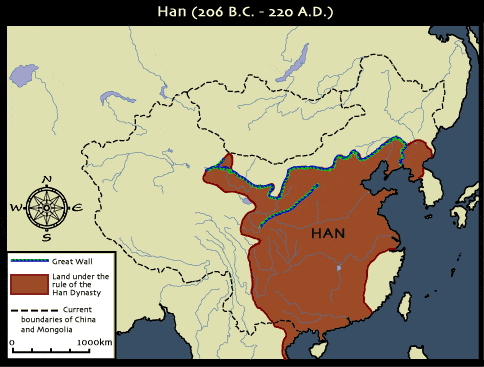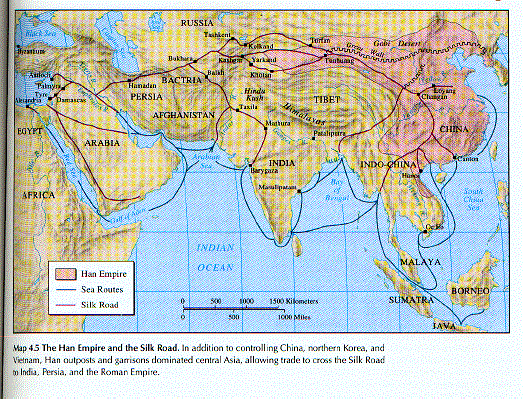Han China Territory
The Han Government had a relatively standard
territory to control (other than Han Wu-ti’s expansion westward form Chinese
Turkestna into Russian Turkestan, eastward toward Korea and southward toward
Vietnam, there was few major changes in territory). (See map below.)
The most military draining part of the Han Dynasty was to protect the Silk
Road and honor the Pax Sinica (whose counterpart was Pax Romana) and to suppress
the attacks of northern Turkish speaking people. (This was a treaty
to make the Silk Road a safe place to travel along, although there were
some parts that were controlled by the Parthians (and therefor unsafe).)
Gold and Silk were valuable commodities in ancient times. Because China had
a total monopoly on the Silk production, it was their most desired export
(along with skins, iron, lacquer and spices). Silk was a form of currency
because it was highly valued and often more valuable than gold (especially
when dyed purple) (there are pictures of Chinese coins at this website).
In 301 Emperor Diocletian's "Edict on Maximum Prices" said raw white silk
was worth one forth its weight in gold, raw silk dyed purple was worth three
times it's weight in gold. Because of the high demand and small supply
of silk, silk was highly valued and bolts of silk were often given as state
gifts. Women's clothing in Rome provided a high demand for silk, to
the dismay of some Roman moralists. The Roman leader and philosopher
Scena once said “I see garments in which there is nothing to cover either
the wearers body or her shame” (on silk) (World History, volume
one (Fourth Edition), Upsher, Terry, Holoka, Goff, and Cassar, Wadsworth Group,
©2002, pages 163-165.)
The silk road was the best and fastest way to travel
form Rome to China. Both Empires spent large amounts of military forces
to protect this road and make it safe for travel. The silk road was
greatest form 300 BCE to 300 CE (the approximate time of the Han Dynasty).
During this time, the large Empires (Han China, The Roman Empire,
Kushan, Mauryan, and Hellenistic) provided a safe route for traders to travel
and encouraged long distance trade. The silk road did not only provide
a route for traders to travel along, it provided a route for religions to
spread. For example, Buddhism spread (partly) along the silk road into
and through China.

 (World History, volume one (Fourth Edition), Upsher, Terry,
Holoka, Goff, and Cassar, Wadsworth Group, ©2002, page
(World History, volume one (Fourth Edition), Upsher, Terry,
Holoka, Goff, and Cassar, Wadsworth Group, ©2002, page 165)



